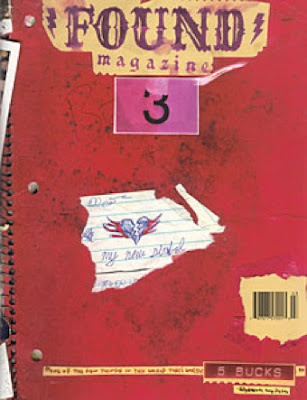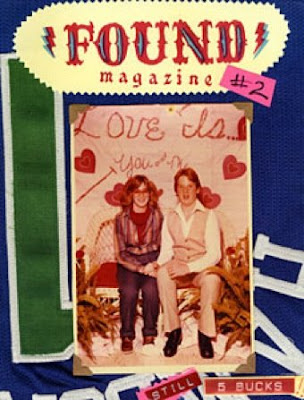

There was an unfortunate clash last week between an art writing night, sponsored by Book Works, and the final night of a European tour by Found magazine, who organised an informal cabaret at the Foyles bookstore cafe. Unfortunate because an expanded culture of art writing and magazines would have combined these events into one almighty cacophony of the highbrow and the vernacular. As it was they played to very different audiences, and those straddling both camps were faced with a choice: art writing or sword swallower.
Decision made, I headed off to the Found night in Foyles. Found have been touring Europe, performing largely in bookstores, coffee shops, and bars, selling their CD's, magazines, and books. The core of the show is the magazines co-founder Davy Rothbart reading from some of the thousands of found texts - love and hate letters, receipts, notes, misdirected faxes - that people around the world have found and sent to the magazine. Found finds people, too, and their show kicks off with sword swallower Brett Loudermilk.
I wasn't, unlike my friend, a pre-existing Found devotee. Sometimes, seeing found material in books or exhibitions, it all seems over fetishized. But Found Live does tend to win over any doubts, partly because the show is hugely entertaining but also because of the contagious conviction Found have about the value of collecting, preserving, and sharing these texts. There is a potent emotional mix in the way such texts can use annonymity, mystery and extremity, to prompt feelings of connection and compassion.

Although the culture of Found magazine is more bands, zines and open-mic nights than art history, I soon found myself making connections, from Kurt Schwitters through to the collage work of Joseph Cornell, Ray Johnson and Jess. Like Cornell and Jess, Found emphasis the domestic, home-made nature of the collage practice: they talk of the sackfulls of mail that turn up at their parents house, full of found letters, receipts, scraps from around the world.
But unlike these other examples, there own working with the material is more a relational one to do with making it available to a world wide network of people, than absorbing it into some artistic universe. Several times at Foyles, Davy Rothbart referred to Found as a "community arts project," one whose community is both local and global, like mail art for an internet age. Presenting the magazine live fits this ethos, aligning the magazine with folk nights, open-mic poetry readings, and stand up comedy. With the sword-swallower there is an older tradition of vaudeville, circus and state-fairs.
I'm avoiding listing specific examples of found texts, apart from this one, found attached to their car, and with which the whole FOUND project began:

It highlights some basic themes about how such texts work that emerged from the evening as a whole. An element of mystery is good, and found texts that were both familiar and elliptical seemed particularly resonant. Some have an excess of emotion whilst others were notable for switches or combinations of different emotions. In truth, although most texts were highly specific to certain situations, they also offered a primer in experimental writing techniques as revealed in till receipts, love letters, hate letters, and the bizarre personal taxonomies of to do lists.

Two other points linger from the night that concern some broader practice of the found. One concerns the level of transformation. Part of the show comprises songs on guitar by Paul Rothbart, that develop out of particular found texts. I found it hard to connect to these at first. As language events the original texts are so strong and lean, that it's odd to encounter them transmuted into someone elses language, in this case a kind of well executed, semi-serious boy band pop-folk. But if you can get into it, it is another layer of response, another part of how to develop relationship to this material. Perhaps it is a part of absorbing these fragments into a celebrating community, which seems part of the FOUND project.
The other lingering question is about what comprises a found text. At one point, Davy Rothbart cited a friend who was "a purist" and said a found text must be blowing down the street. Others assert a right to take any text encountered anywhere.

Trying to think more about the Found aesthetic led me to John Robert Colombo's introduction to his anthology of found poetry within Ronald Gross and George Quasha's Open Poetry: Four Anthologies of Expanded Poems (1973). It's a fascinating collage text of quotes, definitions, and explorations of the found. It was a story of Kurt Schwitters that seemed most relevant here:
"Kurt was at the very back of the streetcar," Hans Richter wrote about the German artist of collage Kurt Schwitters. "He was standing with his hands behind him. Accustomed as I was to his peculiarities, I was nevertheless curious as to why he kept wriggling so. He looked like a shimmy dancer. Suddenly he leapt off the car at a stop. I followed. After the car had gone on, he showed me a 'No Smoking' sign which he had removed from the streetcar with a small screwdriver he always carried. Nothing could stop the man once he wanted some small piece of material for his work." (431)